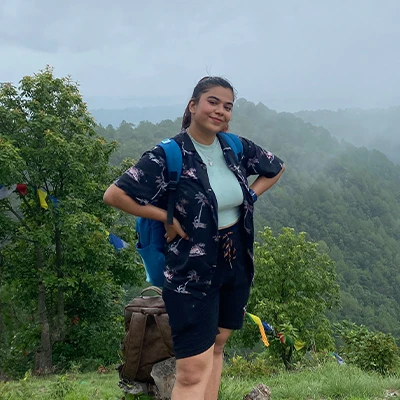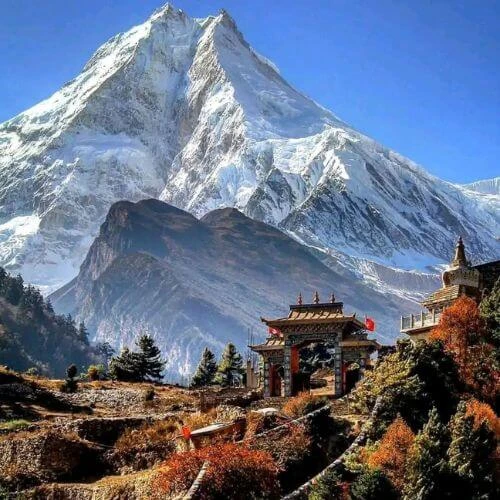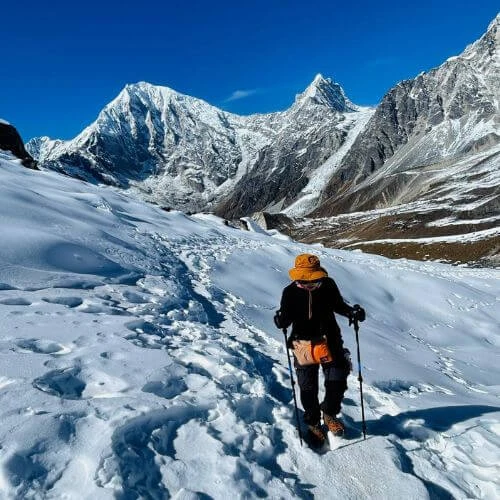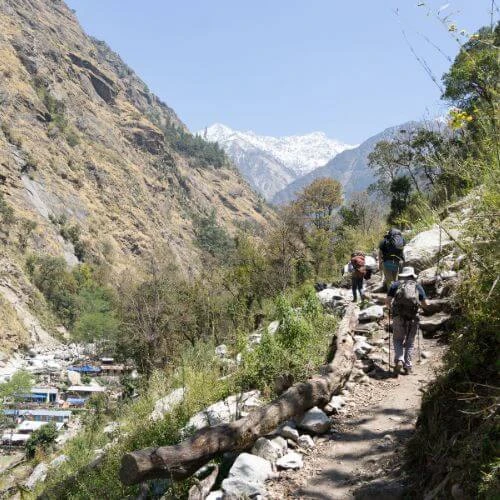Trekking is a form of long-distance walking or hiking that typically takes place in the great outdoors and is done with the express intention of discovering new places and taking in the beauty of their surroundings. A motivation, a purpose, an aim, an objective, a mission, a celebration, or a social gathering could all be accomplished through the activity of trekking. The trekkers have the choice of whether they take the shorter or longer path to their destination. Most travelers to Nepal prefer High-Altitude Treks, those that take them 3500 meters or higher above sea level.
Nepal is host to several world's tallest mountains, including Mount Everest, the highest peak in the world, and is known for having some of the best opportunities for trekking anywhere in the world. Due to the immense number of trekking visitors who visit Nepal, the tourism industry is well prepared to handle all trekking types and locations. Nepal is a Popular Trekking Destination due to its magnificent landscapes, rich history, and welcoming settlements in the Himalayas, home to the world's highest peaks. With its infinite nature and fauna and spectacular panoramic vistas of the fabled Himalayas, Nepal is incomparable. Tourists love Nepal for its risk-free adventure vacations. Nepal has many great treks to offer, including the Everest Base Camp trek and the Annapurna Circuit trek, as well as lesser-known ones like the Kanchenjunga trek, Rolwaling trek (including Parchamo mountain), and Manaslu Circuit trek. As we all know, trekking is typically done at Higher Elevations, or above 2,500 m, where the oxygen level is considerably lower.

As The Level Of Difficulty goes up, there are more things to think about before going on a High-Altitude Trek. You must exercise more and pay more attention while Trekking at Higher Altitudes because something may happen at any time. You must be especially careful to avoid Acute Mountain Sickness and Altitude Sickness, both of which can kill if left untreated. The higher you go, the more dangerous the risks become. Unfortunately, there are no known causes of altitude sickness or severe mountain sickness; it also makes no distinctions based on age, sex, or level of physical fitness.
Knowing that all these risks exist, you must take precautions to lessen any additional risks and prepare for your high-altitude trek by getting as fit as you can. Hiring a guide and a trekking agency that is experienced in organizing trekking at high altitudes is also important to ensure safety and a successful trekking experience. They will have knowledge of the routes, local weather, altitude sickness, and other risks associated with high-altitude trekking, and will be able to manage the risks and ensure a safe and enjoyable trek.
The following are the precautions and measures you can take for Trekking at Higher Altitude in the regions of Nepal:
Drink Enough Water and Eat Enough Carbs
Having enough food and water is essential for a high-altitude trek, as the body requires more energy and hydration during Trekking at higher Altitudes. Make sure to pack enough food or snacks for the duration of the trek, as well as a water filtration system or water purification tablets when trekking at high altitudes. When you are Trekking At High Altitude, your body will burn more calories than it would at sea level. Therefore, you need to make sure that you have enough food to sustain your body through the whole trek. Pack high-energy foods such as nuts, dried fruits, and energy bars. Also, make sure that you have enough water to drink. At high altitude, the air is dry, and you may not feel as thirsty as you would at sea level. However, it is important to drink enough water to prevent dehydration.

Build Up your Cardio Fitness
It is very important to build up your cardiovascular fitness by going for regular hikes or runs to prepare for a high-altitude trek. This will help your body to be able to handle the demands of trekking at high altitudes. When you are trekking at high altitude, your body will have to work harder to pump oxygen to the muscles which will make it harder to breathe. Therefore, training your body to be able to handle this extra workload will make the trek a lot easier. Additionally, incorporating strength training exercises into your routine will help to build up leg and core muscles. This is important because when you are trekking at high altitude, you will be carrying a backpack with all your gear and supplies. The weight of the backpack will put extra stress on your legs and core, so having strong muscles in these areas will help to support your body and reduce the risk of injury. Exercises such as squats, lunges, and deadlifts are great for building leg strength, while planks and core exercises will help to strengthen your core.

Learn About Acclimatization and Rest at Higher Altitudes
Trekking at High Altitude directly can be challenging for your body, so it is important to learn to gradually acclimatize yourself to the higher altitude by spending time at increasing altitudes before your trek. This will help your body to adjust to the lower oxygen levels and will reduce the risk of altitude sickness. Altitude sickness occurs when the body is unable to adapt to the lower oxygen levels at high altitudes. Symptoms include headache, fatigue, nausea, and shortness of breath. To prevent altitude sickness, it is important to give your body time to adjust to the altitude by hiking to higher elevations gradually. A common method is called "Climbing High and Sleeping Low" where you hike to a higher altitude during the day but then descend to a lower altitude to sleep. This allows your body to adjust to the altitude without overstressing it.

Consult Local Travel Agents And Hire A Guide
Choosing a reputable trekking agency and a guide are both important considerations when planning a trek at a high altitude. You should look for an agency that is experienced in organizing treks at high altitudes, and that can provide detailed information about the trek, including the route, difficulty level, and required equipment. Additionally, it is recommended to check for reviews from previous clients and to ask for recommendations from other trekkers or outdoor enthusiasts.
When it comes to hiring a guide, it is important to ensure that the guide is experienced and qualified, and is certified by a reputable organization. It is also important to ensure that the guide has experience in leading treks at high altitudes and is familiar with the particular route you'll be trekking. It is also important to check if the guide has good communication skills.
Overall, choosing a reputable trekking agency and hiring a qualified guide are both important steps in ensuring a safe and enjoyable trekking experience at high altitudes.

Know About High Altitude Sickness and its Preventive measures
Altitude sickness can be a serious and even life-threatening condition, so it is important to learn about the symptoms and how to prevent and treat it. Symptoms of altitude sickness include headache, fatigue, nausea, and shortness of breath. To prevent altitude sickness, it is important to drink plenty of water, avoid alcohol and tobacco, and give your body time to adjust to the altitude by ascending to higher elevations gradually which are important tips for high-altitude trekking. If you do experience symptoms of altitude sickness, the best treatment is to descend to a lower altitude as soon as possible. In some cases, medication such as acetazolamide may be prescribed to help prevent or treat altitude sickness.
Planning and Preparation Are Key to a Successful High Altitude Trek
The planning for trekking at high altitudes includes getting the necessary permits, arranging transportation, and having emergency contact information. It is also important to have a detailed itinerary and a backup plan in case of unexpected events. Before you start your trek, it is important to research the route, the terrain, the weather conditions, and any other factors that may affect your trek. Make sure to have a clear understanding of the duration of the trek, the difficulty level, and the facilities available on the route. Make sure to have all the necessary permits and make sure that you have a reliable means of communication and transportation in case of emergency.
Learn to Hike With a Backpack
Before you start trekking at a high altitude, it is a very important Tip For Altitude Trekking to get used to carrying weight on your back by practicing hiking with a backpack. This will help you better understand the weight and balance of your backpack and help your body adjust to the added stress of carrying a load. When you first start carrying a backpack, it can feel quite heavy and uncomfortable. However, with practice, your body will get used to the extra weight and you will be able to trek longer distances with less discomfort. Make sure to practice hiking with a backpack that is similar in weight to what you will be carrying on your trek. This will give you a better idea of how it will feel to carry your gear for extended periods of time and altitude.

Consult your doctor
If you have any medical issues, it is essential to consult with a guide or doctor before trekking at high altitude. They can help to ensure that you are physically and mentally prepared for the trek and can advise on any necessary precautions or medications. Trekking at high altitude can be physically demanding and may exacerbate certain medical conditions. Therefore, it is important to consult with a doctor if you have any existing medical conditions such as asthma, heart disease, or diabetes. They can advise you on any precautions that you need to take and any medications that you need to bring, which are very important tips for high-altitude trekking. A guide can also help you to navigate through the terrain and help you to avoid potential hazards.
Proper Oxygen Enrichment
The availability of oxygen is very less at high altitudes.To properly enrich your oxygen levels while trekking, it is important to acclimatize by gradually increasing your altitude and allowing your body time to adjust. It is also important to maintain a steady pace and avoid overexertion, as well as staying hydrated and avoiding alcohol and tobacco. Using supplemental oxygen or an oxygen concentrator can also help to increase oxygen levels while trekking at high altitudes. However, it is always best to consult with a doctor before attempting any trek at high altitude and to be aware of the symptoms of altitude sickness.

Avoid Caffeine, Alcohol and Cigarettes
It is recommended to avoid caffeine, alcohol, and cigarettes while trekking at high altitudes because they can increase the risk of altitude sickness and other health problems. Caffeine is a stimulant that can cause dehydration and disrupt sleep, alcohol dehydrates the body and impairs judgment, and smoking constricts blood vessels and reduces oxygen supply. Instead, it is recommended to stay well hydrated by drinking plenty of water and other fluids, consume a balanced diet that includes carbohydrates and electrolytes and get plenty of rest. By avoiding these substances, you can reduce your risk of altitude sickness and other health problems, and increase your chances of having a safe and enjoyable experience of trekking at high altitude. Avoiding these can be a great tip for high-altitude trekking.
Yoga, Meditation and Breathing Exercises
Yoga and meditation can be beneficial for trekking at high altitudes in a number of ways. Yoga can help to improve flexibility, balance, and core strength, which can be important for trekking on uneven terrain and for carrying a heavy backpack. Additionally, certain yoga poses can help to improve lung capacity and breathing efficiency, which can be beneficial for high-altitude trekking where the air is thin. Meditation can help to reduce stress and anxiety, which can be beneficial for dealing with the physical and mental challenges of trekking at high altitudes. Additionally, meditation can be one of the best tips for high-altitude trekking and helps to improve focus and concentration, which can be important for navigating difficult terrain and for dealing with the adverse effects of altitude sickness. It is also important to note that before starting any kind of trek, it is important to prepare yourself physically and mentally through regular exercise, proper hydration, and good nutrition. And it is always better to trek under the guidance of experienced guides.

Medication
High altitude sickness may be treated with a variety of drugs, depending on a doctor's prescription and advice. They consist of:
- Diamox (Acetazolamide) for standard medical treatment for high altitude illness prevention.
- Paracetamol and Ibuprofen for headaches
- Promethazine or other anti-sickness medications for nausea
- Disprin is used to treat headaches and
- Dexamethasone, in only the most severe situations
FAQs About Trekking At High Altitude
How To Train For High Altitude Trek At Sea Level?
Training for a High Altitude Trek at sea level can be challenging, but it is still possible to prepare your body for the demands of the trek. Cardio exercises such as running, cycling, and swimming are good for building endurance. Hiking or walking with a weighted backpack can also help simulate the physical demands of trekking at altitude.
How Do I Deal With Altitude Sickness During A High Altitude Trek?
Gradual acclimatization to higher altitudes is the biggest tip to prevent altitude sickness. This can be achieved by starting your trek at a lower elevation and gradually increasing altitude over several days, allowing your body to adjust. It's also important to stay hydrated and to drink plenty of water to help your body cope with the lack of oxygen at high altitudes. Avoiding alcohol and tobacco can also help to prevent altitude sickness, as these substances can dehydrate the body and make it harder for your body to adjust to the altitude. Taking medication such as Diamox can also help prevent altitude sickness. It's also important to listen to your body, and if you experience symptoms, stop ascending and rest until you feel better.

What Are Three Stages Of Acclimatization To High Altitude?
The three stages of acclimatization are:
- Initial Adjustment: The body adjusts to the lower oxygen levels over the first day or two. During this stage, you may experience mild symptoms such as headache, fatigue, and insomnia.
- Intermediate Adjustment: The body adjusts over the next few days, but symptoms such as headache, fatigue, and insomnia may still be present.
- Final adjustment: The body fully adjusts to the altitude over the next several days. At this stage, symptoms should have subsided, and you should be able to fully enjoy the trek.
What Are The Symptoms Of High Altitude Sickness?
Common symptoms of altitude sickness include headache, nausea, fatigue, dizziness, difficulty sleeping, and loss of appetite. As the altitude increases, these symptoms may become more severe and can lead to more serious forms of altitude sickness such as High Altitude Pulmonary Edema (HAPE) and High Altitude Cerebral Edema (HACE). These symptoms include difficulty breathing, chest tightness, confusion, and loss of coordination.
What Should I Eat During a High Altitude Trek?
High-energy foods such as nuts, dried fruits, and energy bars are good choices for a high-altitude trek. It's also important to stay hydrated and to eat enough carbohydrates to maintain energy levels. Eating a high-carb diet, including pasta, rice, and bread, can help keep you energized. Also, it is important to eat enough protein to support your muscles and to eat enough fats to keep you warm.

What Should I Pack For a High Altitude Trek?
Essential items for a high-altitude trek include warm layers of clothing, waterproof and windproof outerwear, hiking boots, a sleeping bag and pad, a headlamp, a water filter or purification tablets, a first aid kit, and high-energy snacks. You should also bring a personal first aid kit, including blister treatment, painkillers, and any other necessary medication. Sunscreen, sunglasses, and lip balm are also necessary to protect you from the sun's rays. Here is a detailed Packing Checklist for your next High Altitude Trekking.
What Are The Risks of High Altitude Trekking?
High Altitude Trekking can be a challenging and rewarding experience, but it also poses several risks. Altitude sickness is one of the main risks, as the body can struggle to adjust to the decrease in oxygen at high altitudes, leading to symptoms such as headache, nausea, fatigue, and shortness of breath. Hypothermia is another risk, as the body can lose heat faster than it can produce it at high altitudes, where temperatures can drop quickly. Frostbite is a risk as well, particularly for fingers, toes, nose and ears. Falls are also a risk, as the steep and uneven terrain can be challenging to navigate. It is important to be properly prepared, acclimatize properly, and to have a plan in case of an emergency.



 based on 15 reviews
based on 15 reviews












